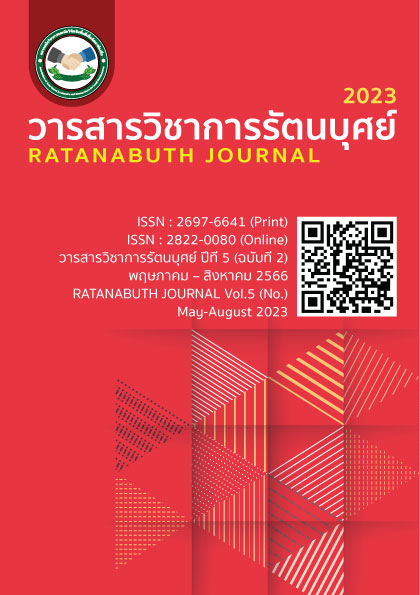The Development of Learning Activities using Storyline Method that Promotes Achievement and Retention in Learning on The Subject of History for Prathomsuksa 5 Students The Development of Learning Activities using Storyline Method that Promotes Achievement and Retention in Learning on The Subject of History for Prathomsuksa 5 Students
Main Article Content
Abstract
The objectives of this research were: 1. To create and find the efficiency of learning activities using storyline method that promotes achievement and retention in learning on the subject of history according to the 80/80 criteria. 2. Study the results of using storyline learning activities as follows: 2.1 Compare the learning achievement of Prathomsuksa 5 students with the criteria of 80%. 2.2 Study the retention of learning of students studying with storyline learning activities. The sample consisted of 24 grade 5 students obtained by cluster random sampling. The experimental period was 3 weeks. The research method was divided into 2 steps: Step 1: Creating and finding the efficiency of storyline learning activities; Step 2: Studying the results of using storyline learning activities. The statistics used for data analysis were mean ( ) , standard deviation (S.D.), t-test (one sample) and t-test (Dependent).
The results showed that:
- Storyline learning activities consisted of 6 activities, namely activities 1. Ayutthaya kingdom 2. Important people in Ayutthaya period 3. Thai wisdom in Ayutthaya period 4. Thonburi kingdom 5. Important people in Thonburi period and 6. Wisdom Thai Thonburi period There are 7 steps in organizing activities: 1. Preparing topic 2. Preparing the subject binding 3. Setting the main question 4. The learners answer the main question 5. Class arrangement 6. Evaluation 7. Determination teaching period When taking it to inspect the quality, it was found that it was at the highest level of suitability. and the activity efficiency was 85.27/83.61
- The student's academic achievement after school was higher than the 80% criterion with a statistical significance at the .05 level.
- The test scores after the test and the test after 2 weeks were not significantly different at the .05 level. The learners had retention in learning.
Article Details

This work is licensed under a Creative Commons Attribution-NonCommercial-NoDerivatives 4.0 International License.
References
กระทรวงศึกษาธิการ. (2554). คู่มือการประเมินสถานศึกษาแบบอย่างการจัดกิจกรรมการเรียนรู้และ บริหารจัดการตามหลักปรัชญาของเศรษฐกิจพอเพียง (สถานศึกษาพอเพียง) ประจำปี 2554-2556. กรุงเทพฯ : กระทรวงศึกษาธิการ.
กระทรวงศึกษาธิการ. (2551). หลักสูตรแกนกลางการศึกษาขั้นพื้นฐาน พุทธศักราช 2551. กรุงเทพฯกระทรวงศึกษาธิการ.
ชัยยงค์ พรหมวงศ์. (2556). การทดสอบประสิทธิภาพสื่อหรือชุดการสอน. วารสารศิลปากร. 5(1), 1 - 16.
ทองพิมพ์ นารถโคษา. (2552). การพัฒนากิจกรรมการเรียนการสอนโดยวิธีสตอรี่ไลน์หน่วยชีวิตกับ เศรษฐกิจ พอเพียง ชั้นประถมศึกษาปีที่ 5 โรงเรียนโพนงามโคกวิทยาคาร สำนักงานเขตพื้นที่การศึกษาสกลนคร เขต 1. สกลนคร: มหาวิทยาลัยราชภัฎสกลนคร
ทิศนา แขมมณี. (2552). ศาสตร์การสอน. (พิมพ์ครั้งที่ 5). กรุงเทพฯ : ด่านสุทธาการพิมพ์จำกัด.
ปนัดดา โภคพิพัฒน์. (2553). การจัดการเรียนรู้แบบเดินเรื่องที่มีต่อผลสัมฤทธิ์ทางการเรียนและเจตคติของนักเรียนชั้นประถมศึกษาปีที่ 6 ในกลุ่มสาระสังคมศึกษา ศาสนา และวัฒนธรรม. วิทยานิพนธ์ ค.ม. (หลักสูตรและการสอน).กรุงเทพฯ: มหาวิทยาลัยราชภัฏรำไพพรรณี.
โรงเรียนอนุบาลเมือง (ท่าหลวงสงเคราะห์). (2564). หลักสูตรสถานศึกษาโรงเรียนอนุบาลเมือง (ท่าหลวงสงเคราะห์). โรงเรียนอนุบาลเมือง (ท่าหลวงสงเคราะห์): จังหวัดพิจิตร.
วารินทร์ รัศมีพรหม. (2542). การออกแบบและพัฒนาระบบการสอน. กรุงเทพฯ: วิชาเทคโนโลยีทางการศึกษา คณะศึกษาศาสตร์ มหาวิทยาลัยศรีนครินทรวิโรฒ.
วลัย พานิช. (2543). การสอนด้วยวิธี Storyline. ในการจัดกิจกรรมการเรียนการสอนด้วยวิธี Storyline. กรุงเทพฯ : ศูนย์ตำราและเอกสารทางวิชาการคณะครุศาสตร์ จุฬาลงกรณ์มหาวิทยาลัย.
สิริวรรณ ศรีพหล. (2554). การจัดการเรียนรู้วิชาสังคมศึกษา.เอกสารประกอบการสอนรายวิชา 472552 สัมมนาหลักสูตรและการสอนสังคมศึกษา.ภาควิชาหลักสูตรและวิธีสอน คณะศึกษาศาสตร์ มหาวิทยาลัยศิลปากร.
สุไรยา หมะจิ, จุฑารัตน์ คชรัตน์ และเก็ตถวา บุญปราการ. (2563). สภาพและปัญหาการจัดการเรียนรู้รายวิชาวิชาประวัติศาสตร์สำหรับนักเรียนชั้นประถมศึกษาปีที่ 4 โรงเรียนเอกชนในสังกัดสำนักงานศึกษาธิการ อำเภอหัวไทร จังหวัด นครศรีธรรมราช. ศษ.ม. หลักสูตรและการสอน. บัณฑิตวิทยาลัย: มหาวิทยาลัยหาดใหญ่.
สำนักงานคณะกรรมการการศึกษาขั้นพื้นฐานกระทรวงศึกษาธิการ. (2560). ตัวชี้วัดและสาระการเรียนรู้แกนกลาง กลุ่มสาระการเรียนรู้วิทยาศาสตร์ (ฉบับปรับปรุง พ.ศ. 2560) ตามหลักสูตรแกนกลางการศึกษาขั้นพื้นฐาน พุทธศักราช 2551. กรุงเทพฯ: โรงพิมพ์ชุมนุมสหกรณ์ การเกษตรแห่งประเทศไทย จำกัด.
อรทัย มูลคำและคณะ. (2542). Child Center : Storyline Method การบูรณาการหลักสูตรการเรียนการสอนโดยยึดผู้เรียนเป็นสำคัญเป็นศูนย์กลาง. กรุงเทพฯ : ดวงกมลสมัย.
อรทัย มูลคำ และสุวิทย์ มูลคำ. (2544). CHILD CENTER : STORY METHOD. ห้างหุ้นส่วนจำกัดภาพพิมพ์.
อริย์ธัช ฉ่ำมณี, อรัญ ซุยกระเดื่อง และอาทิตย์ อาจหาญ. (2562). การพัฒนากิจกรรมการเรียนรู้แบบสตอรี่ไลน์โดยประยุกต์ใช้สื่อออนไลน์ วิชาประวัติศาสตร์ ชั้นประถมศึกษาปีที่ 5. วารสารศึกษาศาสตร์ มหาวิทยาลัยมหาสารคาม. 13(3), 301 – 313.
Lipka, A. K. (1997). The Storyline as an Innovation. School Vaa Beel, 2, 10-13.


